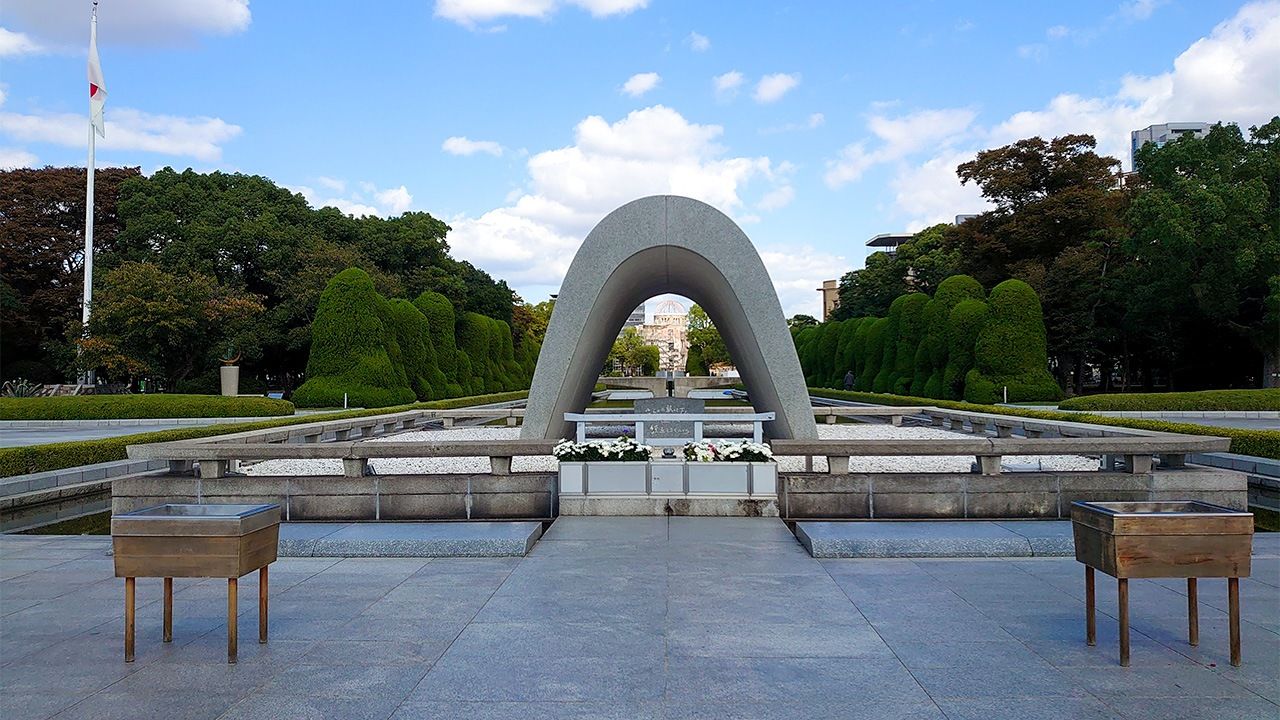
The Children’s Cataclysm: Visiting the Site of the Hiroshima Atomic Bombing
Society Politics History- English
- 日本語
- 简体字
- 繁體字
- Français
- Español
- العربية
- Русский
What I Didn’t Know about Hiroshima
Hiroshima in mid-October, with clear autumn skies that are almost transparent blue, and bright white puffy clouds. A bare trace of summer lingers, the sun still a little too bright and too harsh for autumn, and short sleeves adequate during the day. It’s not hot enough to break a sweat, and not cold enough to want a sweater. The weather could not be more perfect for a tourist.
Having never visited Hiroshima before, I naturally didn’t know anything about this place. The fact that it used to be a garrison town, that it’s a city surrounded by six rivers, that it has a tramway, that Itsukushima Shrine is a World Heritage Site. I found out all these things when I was doing research before setting out on my trip. The one and only thing I did know about Hiroshima was that it had been struck by an atomic bomb. But that recollection was dim, and I couldn’t confidently recall if it had been bombed before or after Nagasaki, or its topography, if someone were to ask me. I may have looked into it when I thought of it, but as it bore no relation to my present life, none of it stuck in my memory. So, I was basically ignorant of Hiroshima.
I did know the words “Atomic Bomb Dome.” If you stop and think about it, that name is a little strange, with its echoes of Tokyo Dome and Taipei Dome. It wouldn’t be odd if someone who knew nothing about it thought it was a magnificent building, like a baseball stadium. I confess that was the case for me. I mistakenly thought that it was a splendid dome-shaped building housing an exhibition of materials relating to the atomic bombing. How could anyone be so ignorant?
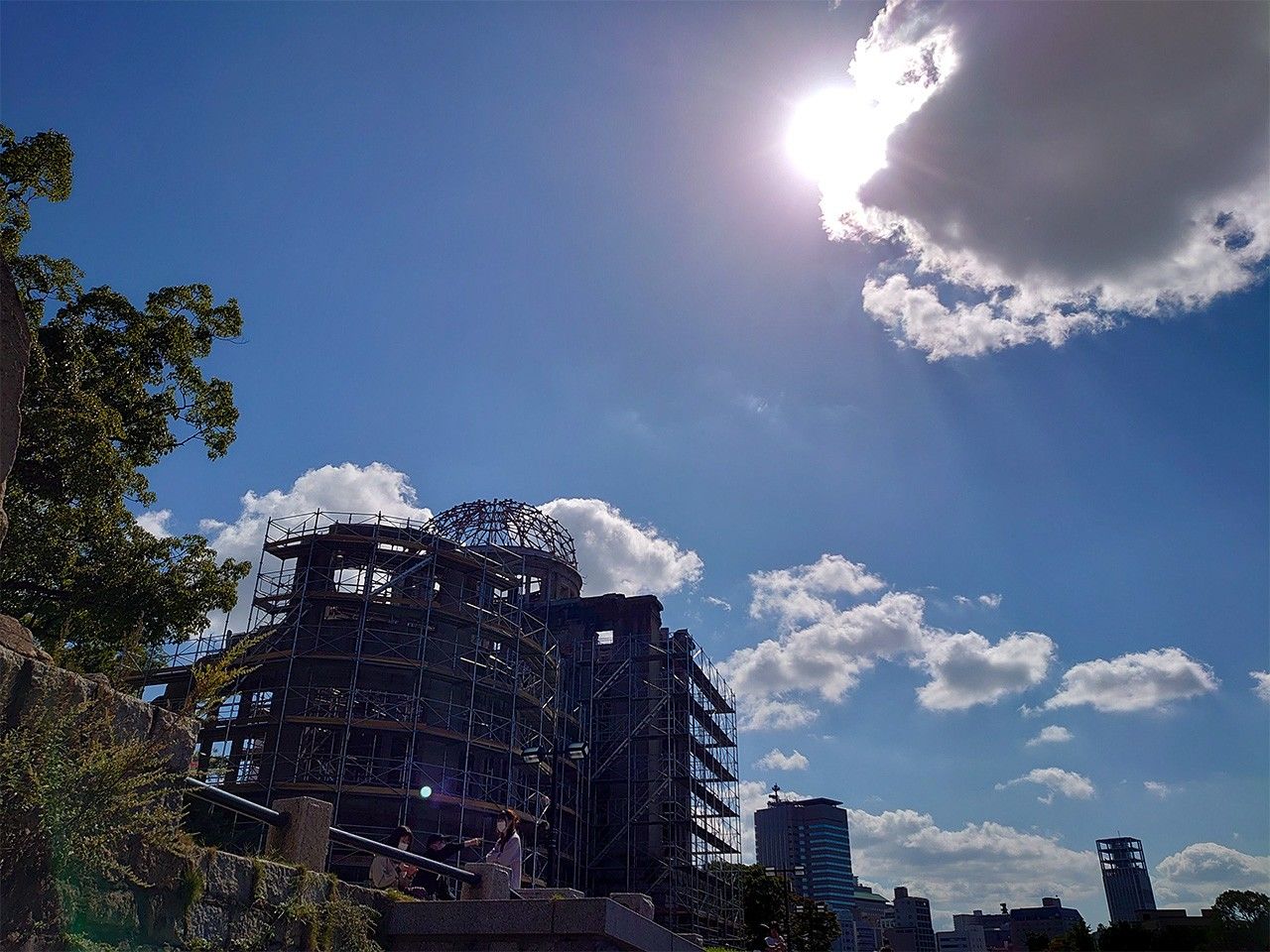
The Atomic Bomb Dome under a blue sky.
Actually, I first heard about the Atomic Bomb Dome at a Japanese language school I attended when I was in high school. One of my teachers, who knew that I had visited northern Kyūshū as part of a package tour, asked me where I had been. I replied “atomic bomb” in my broken Japanese, and he followed up by asking me if it had been the Atomic Bomb Dome. That was when I first heard those words. In fact, even that teacher had mixed up the Nagasaki Atomic Bomb Museum with the Hiroshima Atomic Bomb Dome. If you stop and think about it, the way you can misinterpret words forever, if nothing happens to straighten out your understanding, is pretty frightening. But there actually was a dome-shaped roof on the Nagasaki Atomic Bomb Museum.
I barely remember what I saw at the Nagasaki Atomic Bomb Museum. What stayed in memory was the Peace Statue, along with the origami “Thousand Cranes” that were hanging everywhere. It was more than 10 years ago, and there was probably not enough time to absorb everything at a slow pace, as it was a busy package tour. Plus, my knowledge of the Japanese language at the time doubtless was not sufficient to understand everything properly. Among the photos I took, there wasn’t a single one taken inside the museum. It was probably forbidden to take photos at the time, and I was the kind of kid who obeyed. All this to say that I visited Hiroshima with a fresh pair of eyes, and that made its impact on me that much stronger.
It’s terribly hard to talk about Hiroshima. As the first place in history to have suffered an atomic bomb attack, there have been so many stories over the years—from victims, from their families, from the bereaved, and from their descendants. As someone who was not a victim and who didn’t go through the war, just a traveler who happened to be passing by, anything I would have to say about Hiroshima might come across as impudent to those who were in the thick of it, or just banal. But as I looked at the horrifying exhibits on display at the museum, I suspected that those who would feel nothing would be in a minority. Unfortunately, the burden of being a writer lies in the absolute need to express what one feels in words. This will probably be the only time I do write about the atomic bomb, and so I beg your forgiveness.
As I stood for the first time, facing the Atomic Bomb Dome, I finally understood that it was not “a magnificent dome-shaped building housing exhibits related to the atomic bomb.” It was originally built as the Hiroshima Prefectural Industrial Promotion Hall, and even though it was located close to the center of the blast, it escaped total destruction, leaving just the domed structure at the heart of the building, and the wall around it, standing. As reconstruction got under way after the war, it somehow came to be called the Atomic Bomb Dome by locals, as its frame stood out so clearly in the midst of the devastation. So, in fact, the Atomic Bomb Dome is the remains of a bombed building.
Dropped on a Cloudless Day
The area around this ruin is now the Peace Memorial Park, with densely planted trees bathed in sunshine. There is a walkway along the river, with stone benches to rest on, and the locals can be seen jogging and strolling. One also comes across occasional groups of chattering, excited, elementary schoolchildren clearly out on field trips.
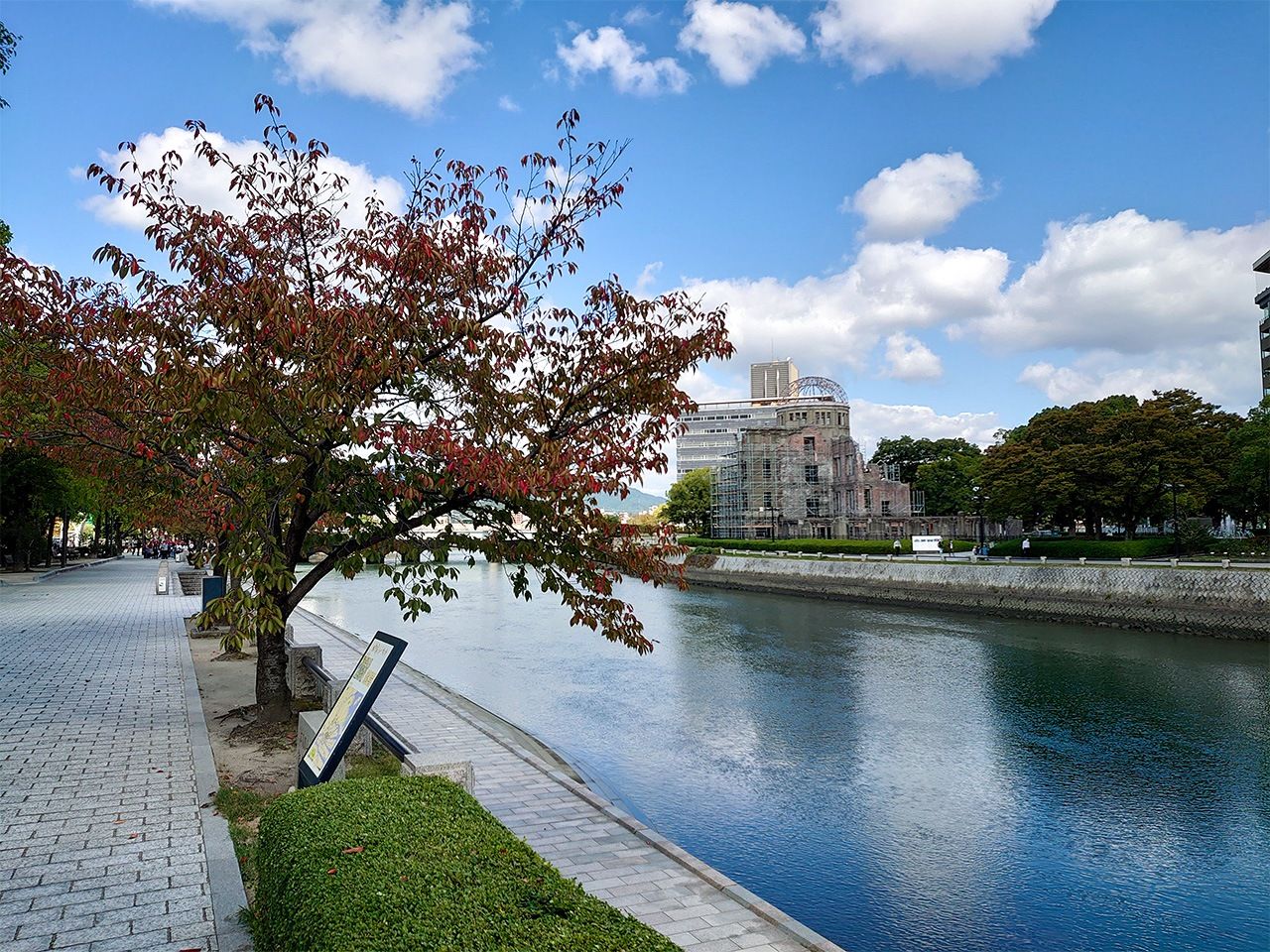
Motoyasu River and the Atomic Bomb Dome. It is said that, immediately after the bombing, the victims sought water and came to the river, which became clogged with dead bodies.
I looked up at the sky, shading my eyes with my right hand. There was that absolutely clear sky, the wind still, gently floating clouds. Cataclysm and devastation seemed a million miles away as I stood, bathed in that tranquil, ordinary air, and I imagined that this place must have felt exactly the same 75 years ago, without so much as a hint of death. People tend to forget, though, perhaps because the photos and images that remain from the time are grainy black and white. But the skies were also clear like this on the day the bomb was dropped. Until the instant when that dazzling flash of death fell from the sky, I imagine that this was a town of tranquil days. In any case, it seems the US Army chose a clear day on purpose to get a clear sighting of the force of the nuclear explosion. And there was no warning, in order to make the impact of the destruction more spectacular.
I tried to imagine that day. Everything was just as it always was. It was a clear summer morning and, with few clouds, it felt a little warmer than usual. I left the house, carrying my boxed lunch. It was the height of summer and the sun was hot, and I was soon sweating. As I hurried to my place of work, I stopped several times to wipe the sweat away. The shopping district I went through was full of people, as usual, really bustling. I stopped to chat with those I knew along the way. And when I came across someone I knew well, we stopped to talk at greater length, as usual. Suddenly, there was a flash of light above me, and I looked up.
And then I died.
140,000 people died.
Are there any other examples of so many people dying so unjustly?
How do you atone for lives that were cut down so meaninglessly?
Ground Zero is about 150 meters away from the Atomic Bomb Dome. At the time, it was the site of a hospital, the Shima Hospital. Afterwards, it became the Shima Orthopedic Clinic, and by the time I visited, it was the Shima Internal Medicine Clinic. It was above that ever-present medical facility that, 75 years ago, a bomb called Little Boy exploded at a height of 600 meters.
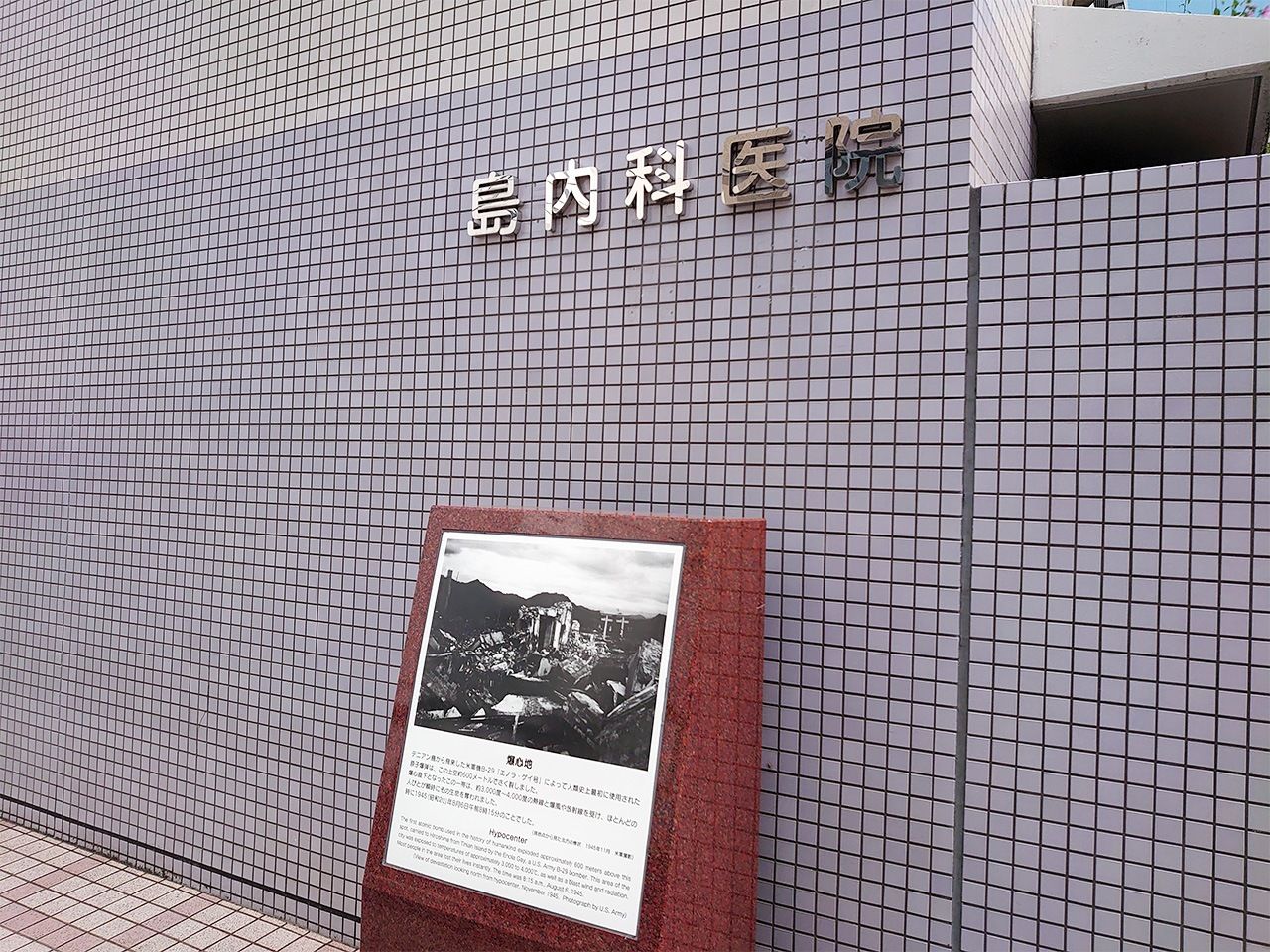
The Shima Internal Medicine Clinic is located at Ground Zero. Its transformation from an orthopedic clinic to an internal medicine clinic is recent.
Little Boy and Sadako
Little Boy. That was the codename given to this weapon of mass destruction, and it leaves such a bad taste. A little boy? A child? And then the one that was dropped on Nagasaki, Fat Man. Of course, since there was a Fat Man, there had to be a Thin Man too (that one was developed but never dropped). The point is that, throughout human history, the ones who could commit mass murder, and who actually committed mass murder, have been, without exception, men. Not a single woman among them.
The child who turned Hiroshima into something unforgettable deprived many children of life with its radiation, thermic rays, and shock waves. Sasaki Sadako was one of them. She was two years old at the time of the bombing. Even though she had been exposed, she suffered no symptoms and grew up healthy. She was good at sports, and she ran relay races when she was at elementary school. And then, when she was in her last year of elementary school, she developed radiation-induced leukemia and died a year later. She was 12 years old. After her death, her classmates wanted to do something in her memory, and started a movement to build a sculpture to commemorate the children of the Atomic Bomb. The copper sculpture was completed two and a half years later, with Sadako as a model. It still stands in the Peace Memorial Park. The inscription carved below the sculpture says “This is our cry. This is our prayer. That there should be peace in the world.”
When I was introduced to the inspiring tale of Sadako and the Children’s Peace Monument, I had an almost indescribable physical reaction. There would of course have been so many more children who also died the same tragic death. And one hardly needs to point out that, regardless of whether they were children or not, the ending of so many people in such an unprecedented cataclysm is unforgivable, and there should never be relative importance placed on those lives. But the early deaths of the children who did not get a chance to grow up does seem to stir up greater compassion in people. And, in order to remember such a major cataclysm, people look for some symbolism in the death of children, often in the death of sweet little girls. When it comes to the Holocaust, that came in the shape of Anne Frank’s Diary of a Young Girl. In the case of Hiroshima, it is Sasaki Sadako. But I can’t help feeling that these girls who are honored as a way of resisting oblivion, and as emblems of the prayers for peace, end up being mere symbols, quite removed from girls who actually lived and breathed.
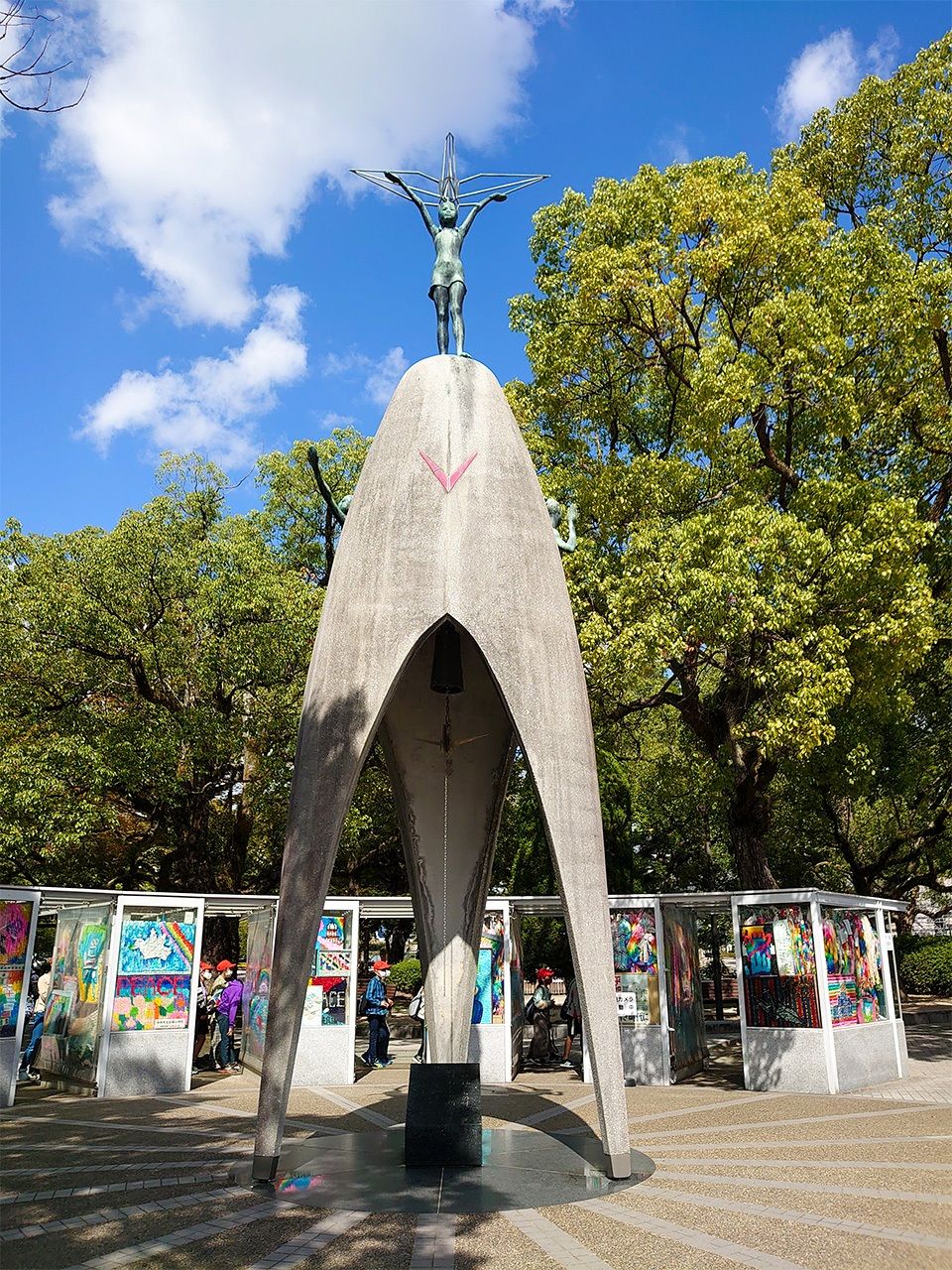
The Children’s Peace Monument.
The Chosen 140,000
Countless objects, film images, photographs, and pictures are exhibited at the Atomic Bomb Museum, conveying the raw misery of the atomic bombing. The town of Hiroshima and people’s lives before the bombing, scenes from the morning of August 6, 1945, people going about their daily lives just before the blast, the dreadful scenes of the immediate aftermath, the movements of people, police, and soldiers, the letters that were exchanged, and the enduring radiation sickness and black rain, are all described in fastidious detail. As I looked at the exhibits, I somehow had a sense of déjà vu. And then I remembered. The feeling I had when I visited the 9/11 Memorial Museum in New York was very similar.
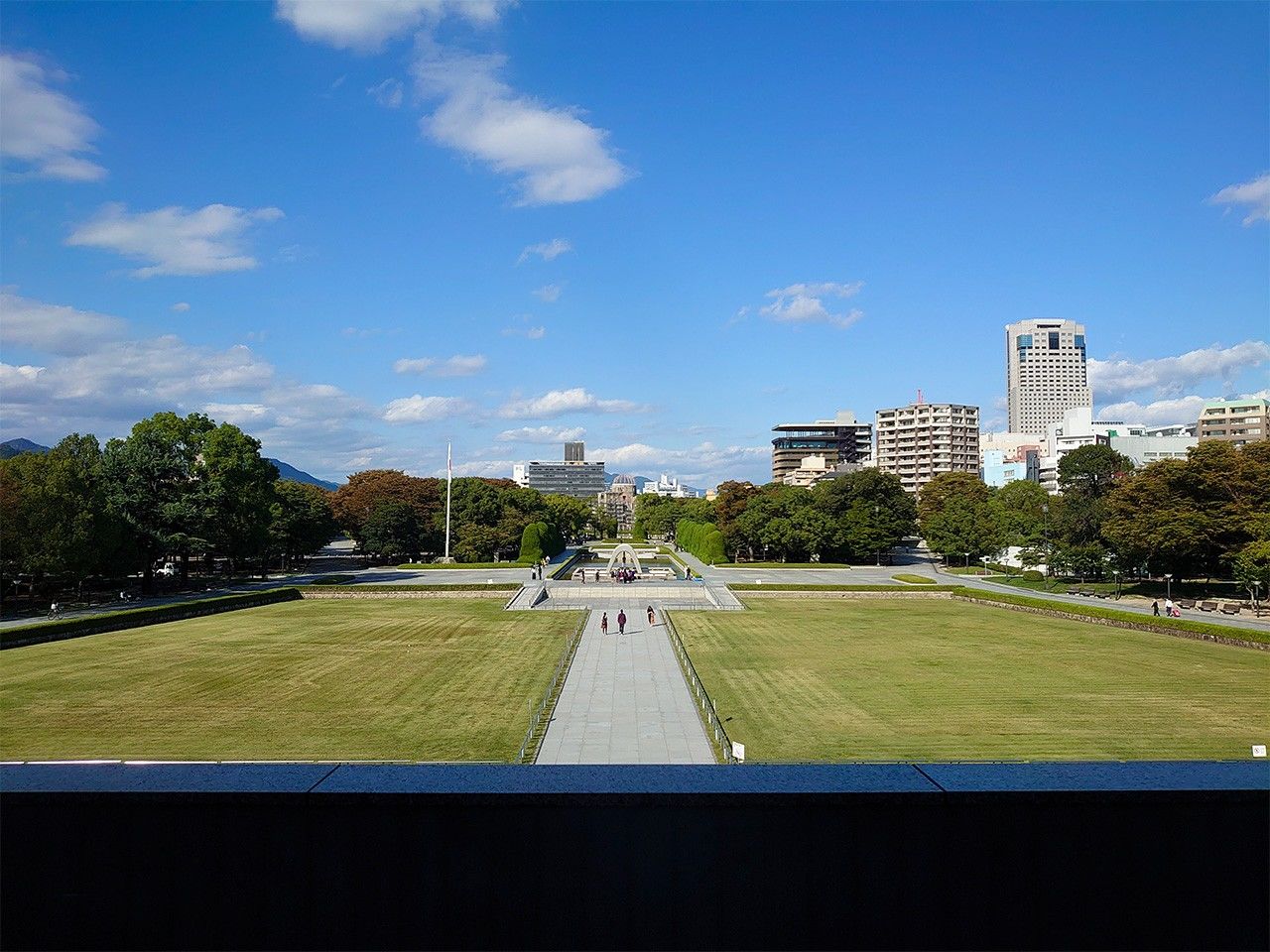
The Peace Memorial Park, seen from the Atomic Bomb Museum.
I suddenly thought of something, and took out my smartphone to check. The number of people who died in what is known as the world’s worst terrorist attack, which led to the war in Afghanistan and the war in Iraq, was 2,977. In contrast, 140,000 people died in Hiroshima.
Even though I can logically understand that there is no relative value to human life, and that these things should not be measured in statistics, that difference shocked me. The scale of that number, those 140,000, weighed even more heavily on me. Of course, one happened in war, the other in peace time. One was part of wartime hostilities, and the other was a terrorist attack. In making a simplistic comparison of the two, it would be difficult to avoid censure for being thoughtless. But I personally fail to understand where the fundamental difference lies between the two when it comes to ordinary citizens whose lives were snuffed out suddenly.
In setting the targets for the atomic bomb, the United States based itself on standards such as “cities with built-up areas” and “causing effective damage with the blast,” making the selection at a closed-door meeting of the Target Committee. Suggestions that came up at the meeting included Kyoto, Kokura in Fukuoka Prefecture, and Niigata, but Hiroshima was selected in the end because it was perceived as both political and military.
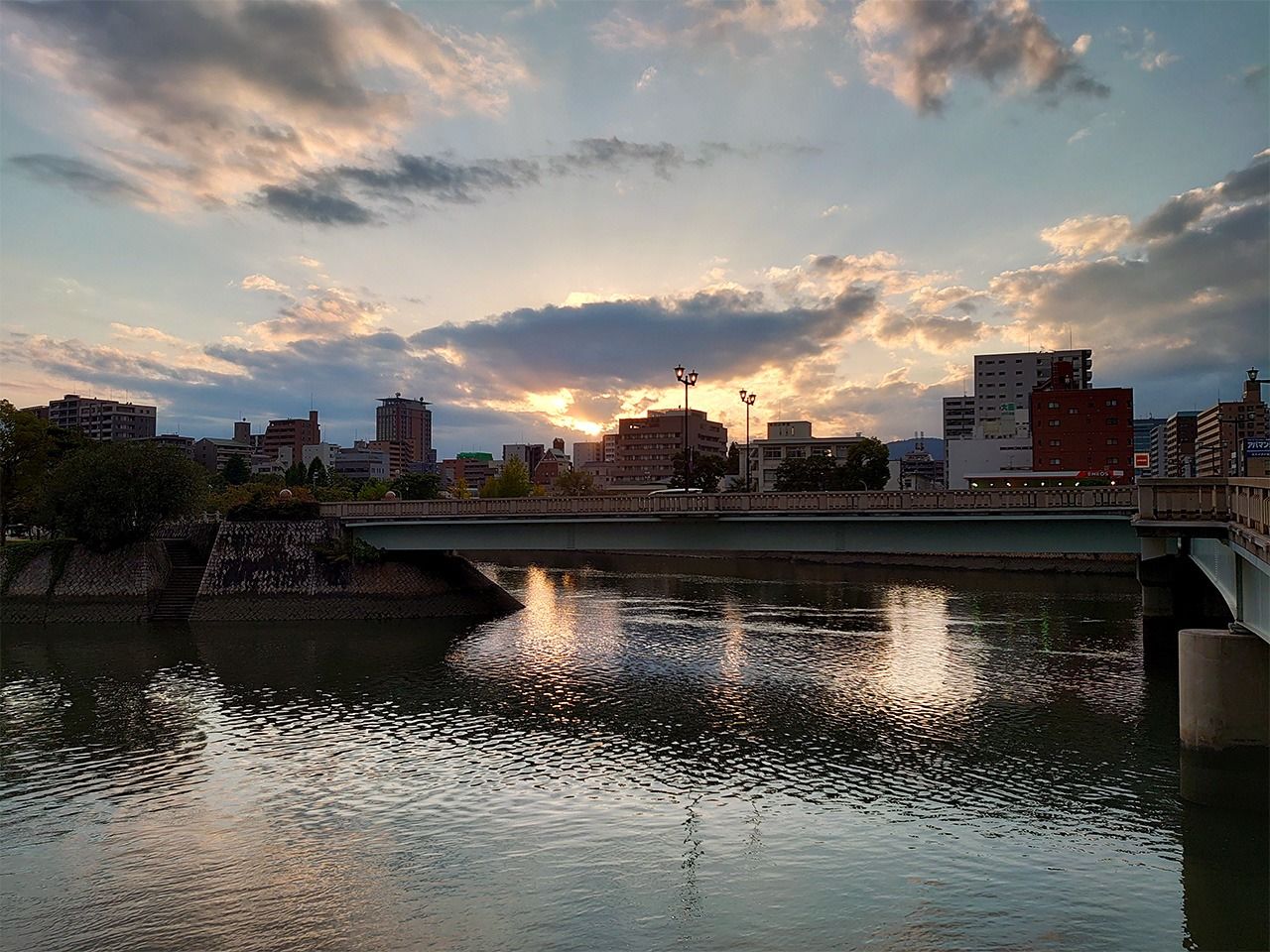
Aioibashi, the bridge that was the target of the bombing. It was selected because of its unusual T-shape.
When I was reading these explanations at the museum, an image popped up from the back of my mind. In a dimly lit conference room, men with moustaches are going through a sheaf of papers, and arguing excitedly. So, should we kill this lot of 140,000? No, that won’t do, let’s kill these 140,000 instead. But that’ll be inconvenient, so let’s make it these 140,000 after all. It’s pretty hard work for a writer to kill off a single character in a novel. But despite all that, these people decided to kill off 140,000 real people at a meeting. It may just have been paperwork for those doing the selecting, but it was unbearable for those who were selected. Their lives were completely upended just because they happened to be in the location that was chosen. In such cases, nationality is irrelevant. People tend to forget this, but it wasn’t just Japanese people who were bombed in Hiroshima and Nagasaki. People from Korea and China who had been drafted into the army, students from Southeast Asia, Jesuit priests from Germany, and American prisoners of war were all affected by the cataclysm. Taiwan being a Japanese colony at the time, there were of course many Taiwanese victims.
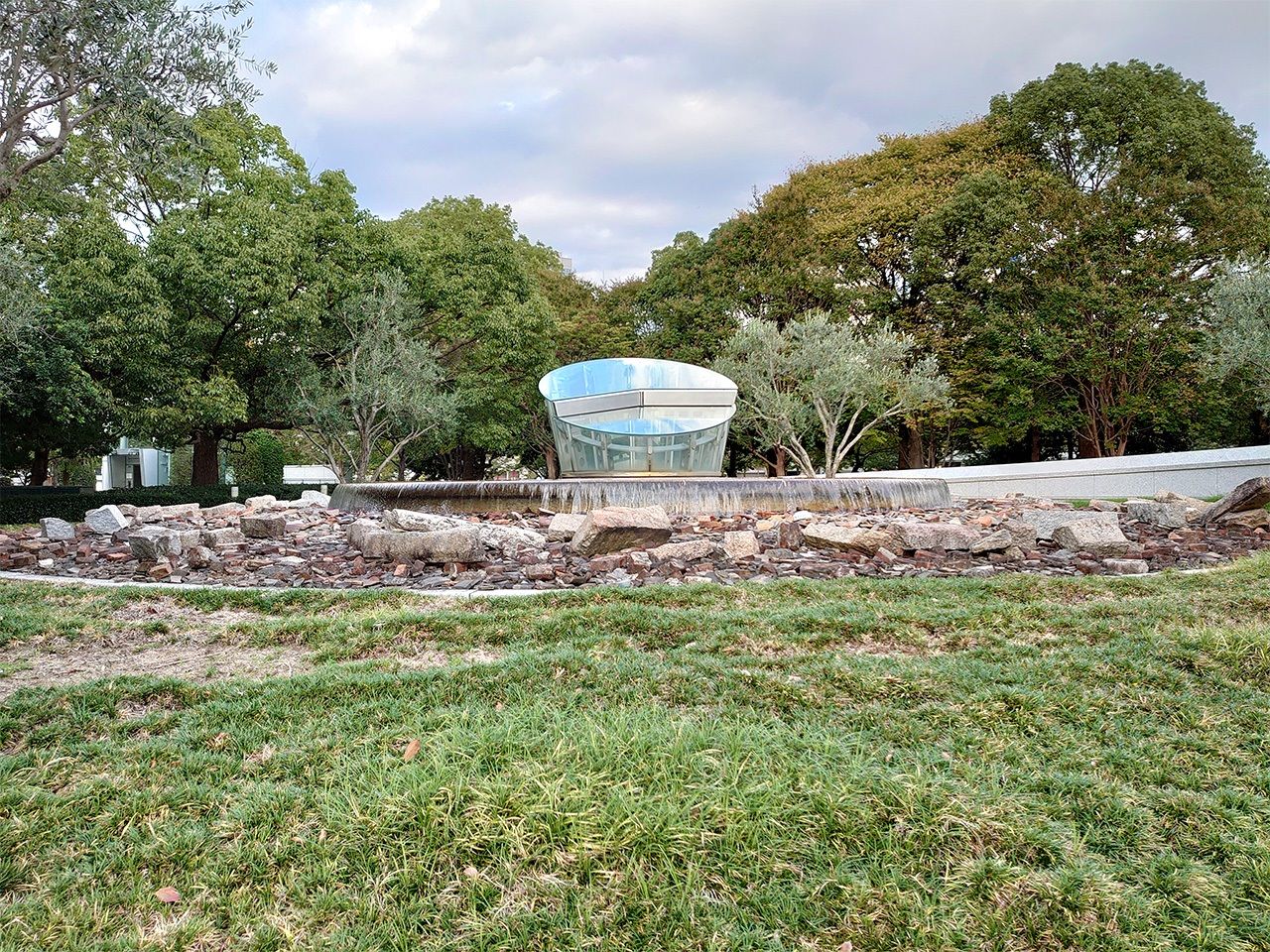
A monument at the Memorial Hall for the Atomic Bomb Victims. The clock is set to 8:15, the time at which the bomb was dropped, and rubble from the bomb destruction is set all around it.
I learned two weeks after I visited Hiroshima that Japan would not be a signatory of the Treaty on the Prohibition of Nuclear Weapons set to go into effect on January 22, 2021. As Japan is the only country that has been a victim of a nuclear attack, this seemed quite incomprehensible to me, but on investigating the matter, there was a reason. The fact is that, in a world where nuclear weapons do exist, signing the treaty as a country benefiting from the American nuclear umbrella’s protection would be self-contradictory for a Japan that cannot afford to incur the distrust of international society, starting with the United States. The theory of nuclear deterrence that brought us so many times to the brink of human extinction in the past, during the arms race between the United States and the Soviet Union, is alive and well. If you look at it that way, you realize by how thin a thread hang our lives and our planet.
In the guidebook, it says that it takes an hour to visit the Atomic Bomb Museum, but I was there for three and a half hours. Spending all that time there would be too much for a tourist, but it was in fact too short to fully face up to that tragic history. When I left the museum, what had been a clear blue sky somehow seemed cloudier, and the western sky was already tinged with the red of the setting sun. The soft breeze as I walked along felt just right to me as I assimilated the massive amount of information I had just ingested, and so I decided to walk all the way to Aioibashi. As opposed to before those three and a half hours, when I had been ignorant, I felt filled with love for the flowers in the Peace Memorial Park, for the twists and turns of the river as it flowed, and for the buildings in the city center, all of which had risen up from that cataclysm.
For me, the meaning of travel may be to increase the number of places to which I feel connected, a little bit at a time. And that holds true, even when that connection is something I can’t share with anyone, something very introspective, and very personal.
(Originally written in Japanese. Banner photo: The Atomic Bomb Dome viewed through the Memorial Cenotaph in Hiroshima Peace Memorial Park. All photos by the author.)
Keisei Skyliner Hiroshima World War II atomic bomb Li Kotomi